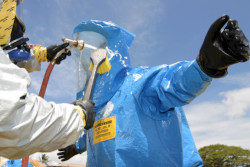Standard Operating Procedures
The first step in decontamination is to establish Standard Operating Procedures (SOPs) that maximizes protection by minimizing contact with waste and thus the potential for contamination.
For example:
- Stress work practices that minimize contact with hazardous substances (e.g., do not walk through areas of obvious contamination, do not directly touch potentially hazardous substances).
- Use remote sampling, handling, and container opening techniques (e.g., drum grapplers, pneumatic impact wrenches).
- Protect monitoring and sampling instruments by bagging. Make openings in the bags for sample ports and sensors that must contact site materials.
- Wear disposable outer garments and use disposable equipment where appropriate. Cover equipment and tools with a strippable coating which can be removed during decontamination.
- Ensure the source of contaminants (e.g., with plastic sheeting or overpacks).
For instance, proper procedures for dressing before entering the Exclusion Zone will minimize the potential for contaminants to bypass the protective clothing and escape decontamination.
In general, do the following:
- Fasteners should be used (i.e., zippers fully closed, all buttons used, all snaps closed, etc.).
- Gloves and boots should be tucked under the sleeves and legs of outer clothing and hoods (if not attached) should be worn outside the collar.
- Another pair of tough outer gloves is often worn over the sleeves.
- All junctures should be taped to prevent contaminants from running inside the gloves, boots, and jackets (or suits, if one-piece construction).
- Before each use, check the personal protective equipment (PPE) to ensure it contains no cuts or punctures that could expose workers to wastes. Any injuries to the skin surface, such as cuts and scratches, may enhance the potential for chemicals or infectious agents that directly contact the worker's skin to penetrate the body. Take care to protect these areas. Workers with large areas of damaged skin should be kept from working on site until the skin heals.
- All personnel should be trained in the Standard Operating Procedures for minimizing contact and maximizing worker protection, and these procedures should be enforced throughout site operations.
Knowledge Check Choose the best answer for the question.
12-3. The first step in decontamination is to establish Standard Operating Procedures (SOPs). How do SOPs maximize the protection of employees?
You forgot to answer the question!

